Dictatorship
A dictatorship is a form of government characterized by a single leader or group of leaders and little or no toleration for political pluralism or independent media.[2] According to other definitions, democracies are a form of government in which "those who govern are selected through contested elections"; therefore, dictatorships are "not democracies".[2]
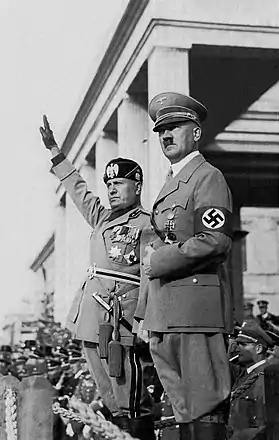
| Part of the Politics series | ||||
| Basic forms of government | ||||
|---|---|---|---|---|
.svg.png.webp) | ||||
| Power source | ||||
|
|
||||
| Power ideology | ||||
|
|
||||
| Power structure | ||||
|
|
||||
|
| ||||
With the advent of the 19th and 20th centuries, dictatorships and constitutional democracies emerged as the world's two major forms of government, gradually eliminating monarchies, one of the traditional widespread forms of government of the time. Typically, in a dictatorial regime, the leader of the country is identified with the title of dictator; although, their formal title may more closely resemble something similar to leader. A common aspect that characterized dictatorship is taking advantage of their strong personality, usually by suppressing freedom of thought and speech of the masses, in order to maintain complete political and social supremacy and stability. Dictatorships and totalitarian societies generally employ political propaganda to decrease the influence of proponents of alternative governing systems.[3][4]
Etymology
The word dictator comes from the Latin language word dictātor, agent noun from dictare (dictāt-, past participial stem of dictāre dictate v. + -or -or suffix).[5] In Latin use, a dictator was a judge in the Roman Republic temporarily invested with absolute power.
Types of dictatorship
A dictatorship has been largely defined as a form of government in which absolute power is concentrated in the hands of a leader (commonly identified as a dictator), a "small clique", or a "government organization", and it aims to abolish political pluralism and civilian mobilization.[6] On the other hand, democracy, which is generally compared to the concept of dictatorship, is defined as a form of government where the supremacy belongs to the population and rulers are elected through contested elections.[7][8]
A newer form of government (originating around the early 20th century) commonly linked to the concept of dictatorship is known as totalitarianism. This form of government is characterized by the presence of a single political party and more specifically, by a powerful leader (a real role model) who imposes his personal and political prominence. The two fundamental aspects that contribute to the maintenance of the power are: a steadfast collaboration between the government and the police force, and a highly developed ideology. Here, the government has "total control of mass communications and social and economic organizations".[9] According to Hannah Arendt, totalitarianism is a new and extreme form of dictatorship composed of "atomized, isolated individuals".[10] In addition, she affirmed that ideology plays a leading role in defining how the entire society should be organized. According to the political scientist Juan Linz, the distinction between an authoritarian regime and a totalitarian one is that while an authoritarian regime seeks to suffocate politics and political mobilization, totalitarianism seeks to control politics and political mobilization.[11]
However, one of the most recent classification of dictatorships does not identify totalitarianism as a form of dictatorship. In Barbara Geddes's study, she focused in how elite-leader and elite-mass relations influence authoritarian politics. Geddes typology identifies the key institutions that structure elite politics in dictatorships (i.e. parties and militaries). The study is based on, and directly related to some factors like: the simplicity of the categorizations, cross-national applicability, the emphasis on elites and leaders, and the incorporation of institutions (parties and militaries) as central to shaping politics. According to Barbara Geddes, a dictatorial government may be classified in five typologies: military dictatorships, single-party dictatorships, personalist dictatorships, monarchies, and hybrid dictatorships.[10]
Military dictatorships
Military dictatorships are regimes in which a group of officers holds power, determines who will lead the country, and exercises influence over policy. High-level elites and a leader are the members of the military dictatorship. Military dictatorships are characterized by rule by a professionalized military as an institution. In military regimes, elites are referred to as junta members; they are typically senior officers (and often other high-level officers) in the military.[10][12] This type of dictatorship was imposed during the 20th century in countries such as, Chile by Augusto Pinochet, Argentina by Jorge Rafael Videla and other leaders, Uruguay by Juan Maria Bordaberry, Paraguay by Alfredo Stroessner, Bolivia by Hugo Banzer, Brazil by Humberto de Alencar Castelo Branco. [13]
Single-party dictatorships
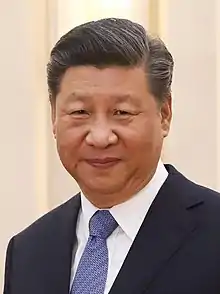
Single-party dictatorships are regimes in which one party dominates politics. In single-party dictatorships, a single party has access to political posts and control over policy. In single-party dictatorships, party elites are typically members of the ruling body of the party, sometimes called the central committee, politburo, or secretariat. These groups of individuals controls the selection of party officials and "organizes the distribution of benefits to supporters and mobilizes citizens to vote and show support for party leaders".[10]
Current one-party states include: China, Cuba, Eritrea, Laos, North Korea, Sahrawi Arab and Vietnam.
Personalist dictatorships
Personalist dictatorships are regimes in which all power lies in the hands of a single individual. Personalist dictatorships differ from other forms of dictatorships in their access to key political positions, other fruits of office, and depend much more on the discretion of the personalist dictator. Personalist dictators may be members of the military or leaders of a political party. Yet, neither the military nor the party exercises power independently from the dictator. In personalist dictatorships, the elite corps are usually made up of close friends or family members of the dictator. These individuals are all typically handpicked to serve their posts by the dictator.[10][14]
According to a 2019 study, personalist dictatorships are more repressive than other forms of dictatorship.[15]
Monarchic dictatorships
Monarchic dictatorships are in regimes in which "a person of royal descent has inherited the position of head of state in accordance with accepted practice or constitution". Regimes are not considered dictatorships if the monarch's role is largely ceremonial, but absolute monarchies, such as Saudi Arabia, can be considered hereditary dictatorships. Real political power must be exercised by the monarch for regimes to be classified as such. Elites in monarchies are typically members of the royal family.[10]
Hybrid dictatorships
Hybrid dictatorships are regimes that blend qualities of personalist, single-party, and military dictatorships. When regimes share characteristics of all three forms of dictatorships, they are referred to as triple threats. The most common forms of hybrid dictatorships are personalist/single-party hybrids and personalist/military hybrids.[10]
Measuring dictatorships
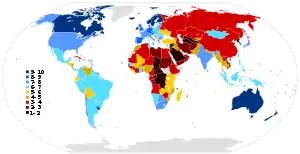
One of the tasks in political science is to measure and classify regimes as either dictatorships or democracies. US based Freedom House, Polity IV and Democracy-Dictatorship Index are three of the most used data series by political scientists.[18]
Generally, two research approaches exist: the minimalist approach, which focuses on whether a country has continued elections that are competitive, and the substantive approach, which expands the concept of democracy to include human rights, freedom of the press, and the rule of law. The Democracy-Dictatorship Index is seen as an example of the minimalist approach, whereas the Polity data series, is more substantive.[19][20][21][22]
History
Between the two world wars, three types of dictatorships have been described: constitutional, counterrevolutionary and fascist. Since World War II, a broader range of dictatorships has been recognized, including Third World dictatorships, theocratic or religious dictatorships and dynastic or family-based dictatorships.[23]
Dictators in the Roman Empire
During the Republican phase of Ancient Rome, a Roman dictator was the special magistrate who held well defined powers, normally for six months at a time, usually in combination with a consulship. Caesar Augustus Germanicus (Alias: Caligula) was the Roman dictator most cruel of the Roman Empire, ruled since 37 A.D. until 47 A.D. [24] [25] Roman dictators were allocated absolute power during times of emergency. In execution, their power was originally neither arbitrary nor unaccountable, being subject to law and requiring retrospective justification. There were no such dictatorships after the beginning of the 2nd century BC, and later dictators such as Sulla and the Roman emperors exercised power much more personally and arbitrarily. A concept that remained anathema to traditional Roman society, the institution was not carried forward into the Roman Empire.
19th-century Latin American caudillos

After the collapse of Spanish colonial rule, various dictators came to power in many liberated countries. Often leading a private army, these caudillos or self-appointed political-military leaders, attacked weak national governments once they controlled a region's political and economic powers, with examples such as Antonio López de Santa Anna in Mexico and Juan Manuel de Rosas in Argentina. Such dictatorships have been also referred to as "personalismos".
The wave of military dictatorships in South America in the second half of the twentieth century left a particular mark on Latin American culture. In Latin American literature, the dictator novel challenging dictatorship and caudillismo is a significant genre. There are also many films depicting Latin American military dictatorships.
Fascist dictatorships of the 20th century
In the first half of the 20th century, fascist dictatorships appeared in a variety of European countries consistent with the rise of communism, which are distinct from dictatorships in Latin America and postcolonial dictatorships in Africa and Asia. The main examples of fascist dictatorship include:
- The Nazi Germany of Adolf Hitler, during the World War II annexed various territories like Luxembourg, Netherlands and Belgium.
- The Empire of Japan which was led by Hideki Tojo and other emperors.
- The Italy Fascist of Benito Mussolini, which would later be renamed as the Italian Social Republic.
- The Austrofascist Austria of Engelbert Dollfuss and succeeded by Kurt Schuschnigg.
- The Protectorate of Bohemia and Moravia of Emil Hácha.
- The Slovak Republic of Jozef Tiso.
- The Portugal of António de Oliveira Salazar
- The Spain of Francisco Franco.
- The France of Philippe Pétain. [26]
- The Romania of Ion Antonescu. [27]
- The Hungary of Miklós Horthy. [28]
- The Greece of Ioannis Metaxas.
- The Croatia of the leader of the group terrorist Ustashe, Ante Pavelic. [29]
Dictatorships of Plan Condor
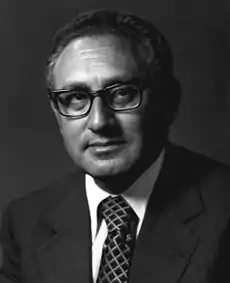
During the Cold War between United States of America and Union of Soviet Socialist Republics, several Overthrows of socialist states in South America were financed and supported by the C.I.A. However, United States had previously made attempts to repress the Communists, the "National Security Doctrine" that United States imposed since the 1950s to indoctrinate the soldiers of countries led by United States to confront the alleged "communist threat", among the dictatorships supported by the C.I.A. are; [13] The Paraguay from the Neo-nazi Alfredo Stroessner after the 1954 Coup d'état. During the last years of Paraguay the general Andres Rodriguez and the eldest son of Alfredo Stroessner, Gustavo Stroessner, but Stroessner wanted their son was his successor trying to move the position of Andres Rodriguez. But before that Andres Rodriguez organized a Coup d'état against the government of Stroessner, was arrested that lasted from. The Brazil after the Coup d'état 1964 that I overthrow to Government from the Socialist João Goulart, the first ruler of the Brazilian Dictatorship was Humberto de Alencar Castelo Branco, the first president after the return of democracy in Brazil in 1985 was José Sarney. [30]
The Chile from Augusto Pinochet after the Coup d'état that ended to Government of Salvador Allende (1970-1973). Among the most famous crime cases of the Dictatorship were the death of the Chilean singer-songwriter Victor Jara and the communist politician Litré Quiroga in the Chile Stadium (renamed as Victor Jara Stadium), the death of the military Carlos Prats and his wife in the Videla's Argentina. The death of Orlando Letelier in Washington, D.C., United States by order of Pinochet, and the Operation Colombo, in which 119 opponents of the dictatorship, whether civilian or political, were killed. The dictatorship ended in 1989 after the process of return to democracy after the triumph of the "No" option, being the first president Patricio Aylwin of this process. The Uruguay of Juan Maria Bordaberry (1973 - 1976). The military government began after the 1973 Coup d'état, in which Juan Maria Bordaberry after closing the parliament, the military government continued with the subsequent leaders named Alberto Demicheli (1976 - 1976), Aparicio Méndez (1976 - 1981), and Gregorio Conrado Álvarez (1981 - 1985) respectively. The military government ended in 1985 with the coming to power of Rafael Addiego Bruno. The Argentina from Jorge Rafael Videla after the 1976 Coup d'état from the Government of Isabel Martínez de Perón, the dictatorship ended in 1983. The Bolivia of Hugo Banzer after the 1971 Coup d'état of the Socialist Government of Juan José Torres, who would later be assassinated, the dictatorship ended in 1978, in 1997 the country Bolivian again governed, but unlike the first government, this second one was through democratic elections. The Peru from Francisco Morales-Bermúdez, who ruled from 1975 to 1980, formerly Juan Velasco Alvarado. One of the crimes with the most gender controversy was the death of 13 opponents to Bermúdez, years after the Dictatorship, Bermúdez was tried for this crime in Roma, Italy. [31]
Others dictatorships
In 1931 was organized a 1931 Coup d'état against the government of Arturo Araujo, starting the period known as Military Dictatorship of El Salvador from Civic Directory. The government committed several crimes against humanity, such as La Matanza ( The Massacre in english), a peasant uprising in which the military murdered between 10,000 to 40,000 peasants and civilians, the dictatorship ended in 1979.
From 1942 to 1952 Rafael Leonidas Trujillo ruled Dominican Republic, repressing the Communists and their opponents. Trujillo ordered the assassination of Romulo Betancourt, who was the founder of Democratic Action, but before he found out about this ambush, the plan of Leonidas Trujillo failure. In October 1937 the Parsley massacre took place in which the main objective was to assassinate immigrants Hatians residing in Dominican Republic, it is estimated that the dead during the massacre were 12,168 dead, by the president Haitian Élie Lescot, 12,136 dead and 2419 injured by Jean Price-Mars, 17,000 dead by Joaquin Balaguer and 35,000 killed by Bernardo Vega. The Dictatorship ended when Trujillo was assassinated in 1961 in the city of Santo Domingo.
On November 24, 1948 Venezuelan armed forces took power based on a Coup d'état, overthrowing the government of Romulo Gallegos, who was a president of center left. Subsequently, a board composed of 3 generals was organized, one of them was Marcos Perez Jimenez, who later became dictator of Venezuela. The dictatorship repressed the Democratic Action and the Communist Party of Venezuela, both from left. Pedro Estrada led the DSN, which was a military organization Venezuelan that repressed opponents and protesters. Among the cases of crimes against humanity are the death of the Democratic Action politician, Antonio Pinto Salinas who was assassinated while trying to flee from Venezuela. In 1958 an attempt was organized to overthrow Perez Jimenez, faced with political pressure Jimenez had to get rid of many of his allies such as Pedro Estrada. That same year, a movement of civilians and military men joined forces to force Marcos Perez Jimenez and his most loyal ministers to leave the country. The dictatorship ended when Marcos Perez Jimenez was exiled from the country, the civilians were To celebrate in the street, the political prisoners were released and the exiles returned to the country, the Venezuelans once again elected Romulo Betancourt, who had already been president years ago. However, he continued to use the political and economic system of the Jimenez dictatorship.
Although a large part of the Latin American dictatorships were from Right, the Soviet Union support and backing Socialist States in Latin America. The Cuba from Fidel Castro was a great example of this, the government was established after the Cuban Revolution that overthrew the government from the dictator Fulgencio Batista in 1959, being the first Socialist State of the Western Hemisphere. In 2008 Castro he left power, being replaced by his brother Raul.
In 1972 Guillermo Rodriguez Lara established a dictatorial government, and called his government the "Nationalist Revolution." In 1973, the country's entry into the organization OPEC was promoted, the government also imposed agrarian reforms in practice. The dictatorship ended in 1976.
Dictatorships in Africa and Asia after World War II
%252C_Bernhard_en_Mobutu%252C_Bestanddeelnr_926-6037.jpg.webp)
After World War II, dictators established themselves in the several new states of Africa and Asia, often at the expense or failure of the constitutions inherited from the colonial powers. These constitutions often failed to work without a strong middle class or work against the preexisting autocratic rule. Some elected presidents and prime ministers captured power by suppressing the opposition and installing one-party rule and others established military dictatorships through their armies. Whatever their form, these dictatorships had an adverse impact on economic growth and the quality of political institutions.[32] Dictators who stayed in office for a long period of time found it increasingly difficult to carry out sound economic policies.
The often-cited exploitative dictatorship is the regime of Mobutu Sese Seko, who ruled Zaire from 1965 to 1997, embezzling over $5 billion from his country.[33] Pakistan is another country to have been governed by 3 military dictators for almost 32 years in 7 decades of its existence. Starting with General Muhammad Ayub Khan who ruled from 1958–1969. Next was General Zia-ul-Haq who usurped power in 1977 and held on to power the longest until he died in an air crash in 1988. Ten years after Zia, General Pervez Musharraf got control after defeat against India in the Kargil war. He remained in power for 9 years until 2008.[34] Suharto of Indonesia is another prime example, having embezzled $15-35 billion[35][36] during his 31-year dictatorship known as the New Order. In the Philippines, the conjugal dictatorship[37] of Ferdinand Marcos and Imelda Marcos embezzled billions of dollars in public funds,[38][39][40] while the nation's foreign debt skyrocketed from $599 million in 1966 to $26.7 billion in 1986, with debt payment being reachable only by 2025.[41] The Marcos dictatorship has been noted for its anti-Muslim killings,[42][43][44][45] political repression, censorship, and human rights violations,[46] including various methods of torture.[47]
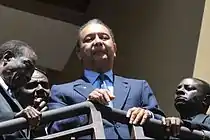
_02.jpg.webp)
Democratization
The global dynamics of democratization has been a central question for political scientists.[48][49] The Third Wave Democracy was said to turn some dictatorships into democracies[48] (see also the contrast between the two figures of the Democracy-Dictatorship Index in 1988 and 2008).
One of the rationales that the Bush Administration employed periodically during the run-up to the 2003 invasion of Iraq is that deposing Saddam Hussein and installing a democratic government in Iraq would promote democracy in other Middle Eastern countries.[50] However, according to The Huffington Post, "The 45 nations and territories with little or no democratic rule represent more than half of the roughly 80 countries now hosting U.S. bases. ... Research by political scientist Kent Calder confirms what's come to be known as the "dictatorship hypothesis": The United States tends to support dictators [and other undemocratic regimes] in nations where it enjoys basing facilities."[51]
Theories of dictatorship
Mancur Olson suggests that the emergence of dictatorships can be linked to the concept of "roving bandits", individuals in an atomic system who move from place to place extracting wealth from individuals. These bandits provide a disincentive for investment and production. Olson states that a community of individuals would be served less badly if that bandit were to establish himself as a stationary bandit to monopolize theft in the form of taxes. Except from the community, the bandits themselves will be better served, according to Olson, by transforming themselves into "stationary bandits". By settling down and making themselves the rulers of a territory, they will be able to make more profits through taxes than they used to obtain through plunder. By maintaining order and providing unsollicited protection to the community, the bandits will create an environment in which people can increase their surplus which means a greater taxable base. Thus a potential dictator will have a greater incentive to provide an illusion of security to a given community from which he is extracting taxes and conversely, the unthinking part of the people from whom he extracts the taxes are more likely to produce because they will be unconcerned with potential theft by other bandits. This is the rational that bandits use in order to explain their transformation from "roving bandits" into "stationary bandits".[52]
See also
- Absolute monarchy
- Autocracy
- Benevolent dictatorship
- Civil-military dictatorship
- Constitutional dictatorship
- Stalinism
- Maoism
- Juche
- Dictatorship of the bourgeoisie
- Dictatorship of the proletariat
- Despotism
- Elective dictatorship
- Family dictatorship
- How Democracies Die
- Military dictatorship
- Generalissimo
- List of titles used by dictators
- Maximum Leader
- Mobutism
- Nazism
- Fascism
- People's democratic dictatorship
- Right-wing dictatorship
- Selectorate theory
- Strongman
- Supreme leader
- Theocracy
References
- Del Testa, David W; Lemoine, Florence; Strickland, John (2003). Government Leaders, Military Rulers, and Political Activists. Greenwood Publishing Group. p. 83. ISBN 978-1-57356-153-2.
- Ezrow, Natasha (2011). Dictators and dictatorships : understanding authoritarian regimes and their leaders. Frantz, Erica. New York: Continuum. ISBN 978-1-4411-1602-4. OCLC 705538250.
- Tucker, Robert C. (1965). "The Dictator and Totalitarianism". World Politics. 17 (4): 555–83. doi:10.2307/2009322. JSTOR 2009322. OCLC 4907282504.
- Cassinelli, C. W. (1960). "Totalitarianism, Ideology, and Propaganda". The Journal of Politics. 22 (1): 68–95. doi:10.2307/2126589. JSTOR 2126589. OCLC 6822391923.
- "Oxford English Dictionary, (the definitive record of the English language)".
- Olson, Mancur (1993). "Dictatorship, Democracy, and Development". The American Political Science Review. 87 (3): 567–76. doi:10.2307/2938736. JSTOR 2938736. OCLC 5104816959.
- Kurki, Milja (2010). "Democracy and Conceptual Contestability: Reconsidering Conceptions of Democracy in Democracy Promotion" (PDF). International Studies Review. 12. no. 3 (3): 362–86. doi:10.1111/j.1468-2486.2010.00943.x. JSTOR 40931113.
- Bermeo, Nancy (1992). "Democracy and the Lessons of Dictatorship". Comparative Politics. 24 (3): 273–91. doi:10.2307/422133. JSTOR 422133.
- McLaughlin, Neil (2010). "Review: Totalitarianism, Social Science, and the Margins". The Canadian Journal of Sociology. 35 (3): 463–69. doi:10.29173/cjs8876. JSTOR canajsocicahican.35.3.463.
- Ezrow, Natasha M; Frantz, Erica (2011). Dictators and dictatorships: understanding authoritarian regimes and their leaders. New York: Continuum. ISBN 978-1-4411-1602-4.
- Linz, Juan J (2009). Totalitarian and authoritarian regimes. Boulder, CO: Rienner. ISBN 978-1-55587-866-5. OCLC 985592359.
- Friedrich, Carl (1950). "Military Government and Dictatorship". The Annals of the American Academy of Political and Social Science. 267: 1–7. doi:10.1177/000271625026700102. OCLC 5723774494. S2CID 146698274.
- Mar Romero (11 August 2019). "La Operación Condor y la persecución de la izquierda en America Latina" (in Spanish). Latin America: Mar_RomeroS. EOM. p. elordenmundial.com. Retrieved 28 January 2021.
- Peceny, Mark (2003). "Peaceful Parties and Puzzling Personalists". The American Political Science Review. 97 (2): 339–42. doi:10.1017/s0003055403000716. OCLC 208155326.
- Frantz, Erica; Kendall-Taylor, Andrea; Wright, Joseph; Xu, Xu (27 August 2019). "Personalization of Power and Repression in Dictatorships". The Journal of Politics. 82: 372–377. doi:10.1086/706049. ISSN 0022-3816.
- "Call them ‘Dictators’, not ‘Kings’". Dawn. 28 January 2015.
- "Democracy Index 2015" (PDF). Economist Intelligence Unit. 21 January 2016.
- William Roberts Clark; Matt Golder; Sona N Golder (23 March 2012). "5. Democracy and Dictatorship: Conceptualization and Measurement". Principles of Comparative Politics. CQ Press. ISBN 978-1-60871-679-1.
- "Democracy and Dictatorship: Conceptualization and Measurement". cqpress.com. 17 August 2017.
- Møller, Jørgen; Skaaning, Svend-Erik (2012). Requisites of Democracy: Conceptualization, Measurement, and Explanation. Routledge. pp. 78–. ISBN 978-1-136-66584-4.
- Clark, William Roberts; Golder, Matt; Golder, Sona Nadenichek (2009). Principles of comparative politics. CQ Press. ISBN 978-0-87289-289-7.
- Divergent Incentives for Dictators: Domestic Institutions and (International Promises Not to) Torture Appendix "Unlike substantive measures of democracy (e.g., Polity IV and Freedom House), the binary conceptualization of democracy most recently described by Cheibub, Gandhi and Vree-land (2010) focuses on one institution—elections—to distinguish between dictatorships and democracies. Using a minimalist measure of democracy rather than a substantive one better allows for the isolation of causal mechanisms (Cheibub, Gandhi and Vreeland, 2010, 73) linking regime type to human rights outcomes."
- Frank J. Coppa (1 January 2006). Encyclopedia of Modern Dictators: From Napoleon to the Present. Peter Lang. p. xiv. ISBN 978-0-8204-5010-0. Retrieved 25 March 2014.
In the period between the two world wars, three types of dictatorships were described by a number of smart people: constitutional, the counterrevolutionary, and the fascist. Many have rightfully questioned the distinctions between these prototypes. In fact, since World War II, we have recognized that the range of dictatorships is much broader than earlier posited and it includes so-called Third World dictatorships in Africa, Asia, Latin America, and the Middle East and religious dictatorships....They are also family dictatorships ....
- Alfredo Serra (25 February 2018). "Delirio, locura y crímenes de Caligula, el más cruel de los emperadores romanos". Caligula's crimes (in Spanish). Argentina. infobae. p. infobae.com. Retrieved 28 January 2021.
- "Calígula, el césar al que todo estaba permitido" [Caligula, the Caesar to whom everything was allowed] (in Spanish). 8 June 2015: historia.nationalgeographic.com.es. Retrieved 28 January 2021. Cite journal requires
|journal=(help) - "Was Vichy France a Puppet Government or a Willing Nazi Collaborato?" (History). 9 November 2017. p. smithsonianmag.com. Retrieved 23 January 2021.
- "Ruler of Romania "Ion Antonescu"". p. britannica.com. Retrieved 23 January 2021.
- "The Horthy Era (1920 - 1944)" (History). p. The Orange Files. Retrieved 23 January 2021.
- "Ante Pavelic, Croatian War Criminal" (Biography). 4 October 2019. p. thoughtco.com. Retrieved 23 January 2021.
- "Dictadura de Brasil" (History) (in Spanish): rioandlearn.com. Retrieved 26 January 2021. Cite journal requires
|journal=(help) - Jacqueline Fowks (18 January 2017). "Italia condena a cadena perpetua a un ex dictador peruano por el Plan Condor" (News) (in Spanish). España. elpais. p. elpais.com. Retrieved 26 January 2021.
- Papaioannou, Kostadis; vanZanden, Jan Luiten (2015). "The Dictator Effect: How long years in office affect economic development". Journal of Institutional Economics. 11 (1): 111–39. doi:10.1017/S1744137414000356.
- "Mobutu dies in exile in Morocco". CNN. 7 September 1997.
- "A brief history of military rule in Pakistan". D+C. Retrieved 22 March 2019.
- Global Corruption Report 2004: Political Corruption by Transparency International - Issuu. Pluto Press. 2004. p. 13. ISBN 0-7453-2231-X – via Issuu.com.
- "Suharto tops corruption rankings". BBC News. 25 March 2004. Retrieved 4 February 2006.
- Mijares, Primitivo. The Conjugal Dictatorship of Ferdinand Marcos and Imelda Marcos, Union Square Publishing, Manila, 1976. ISBN 1-141-12147-6.
- McGeown, Kate (25 January 2013). "What happened to the Marcos fortune?". BBC News.
- "Imelda Marcos sentenced to 42 years for £154m fraud". 9 November 2018 – via www.telegraph.co.uk.
- "[ANALYSIS] Just how bad was corruption during the Marcos years?". Rappler.
- Inquirer, Philippine Daily (18 March 2016). "'We'll pay Marcos debt until 2025'". INQUIRER.net.
- "Murad: Marcos regime's genocidal war vs. Muslims drove us to armed struggle". GMA News Online.
- "FALSE: 'No massacres' during Martial Law". Rappler.
- "Fighting and talking: A Mindanao conflict timeline". GMA News and Public Affairs. 27 October 2011. Archived from the original on 13 March 2012. Retrieved 5 May 2012.
- Aquino Jr., Benigno S. (28 March 1968). "Jabidah! Special Forces of Evil?". Delivered at the Legislative Building, Manila, on 28 March 1968. Government of the Philippines.
- To Islands Far Away: the Story of the Thomasites and Their Journey to the Philippines. Manila: US Embassy. 2001.
- "Worse than death: Torture methods during martial law". Rappler.
- Samuel P. Huntington (6 September 2012). The Third Wave: Democratization in the Late 20th Century. University of Oklahoma Press. ISBN 978-0-8061-8604-7.
- Nathan J. Brown (2011). The Dynamics of Democratization: Dictatorship, Development, and Diffusion. JHU Press. ISBN 978-1-4214-0088-4.
- Wright, Steven. The United States and Persian Gulf Security: The Foundations of the War on Terror, Ithaca Press, 2007 ISBN 978-0-86372-321-6
- "How U.S. Military Bases Back Dictators, Autocrats, And Military Regimes". The Huffington Post]. 16 May 2017.
- Olson, Mancur (1993). "Dictatorship, Democracy, and Development". American Political Science Review. 87 (3): 567–576. doi:10.2307/2938736. JSTOR 2938736.
Further reading
- Behrends, Jan C. Dictatorship: Modern Tyranny Between Leviathan and Behemoth, in Docupedia Zeitgeschichte, 14 March 2017
- Dikötter, Frank. How to Be a Dictator: The Cult of Personality in the Twentieth Century (2019) scholarly analysis of eight despots: Mussolini, Hitler, Stalin and Mao, as well as Kim Il-sung of North Korea; François Duvalier, or Papa Doc, of Haiti; Nicolae Ceaușescu of Romania; and Mengistu Haile Mariam of Ethiopia. online review; also excerpt
- William J. Dobson (2013). The Dictator's Learning Curve: Inside the Global Battle for Democracy. Anchor. ISBN 978-0-307-47755-2.
- Finchelstein, Federico. The ideological origins of the dirty war: Fascism, populism, and dictatorship in twentieth century Argentina (Oxford UP, 2017).
- Fraenkel, Ernst, and Jens Meierhenrich. The dual state: A contribution to the theory of dictatorship. (Oxford UP, 2018).
- Friedrich, Carl J.; Brzezinski, Zbigniew K. (1965). Totalitarian Dictatorship and Autocracy (2nd ed.). Praeger.
- Bueno de Mesquita, Bruce; Smith, Alastair; Siverson, Randolph M.; Morrow, James D. (2003). The Logic of Political Survival. The MIT Press. ISBN 978-0-262-63315-4.
- Bruce Bueno de Mesquita and Alastair Smith (2011). The Dictator's Handbook: Why Bad Behavior is Almost Always Good Politics. Random House. p. 272. ISBN 978-1-61039-044-6. OCLC 701015473.
- Ridenti, Marcelo. "The Debate over Military (or Civilian‐Military?) Dictatorship in Brazil in Historiographical Context." Bulletin of Latin American Research 37.1 (2018): 33–42.
- Ringen, Stein. The perfect dictatorship: China in the 21st century (Hong Kong UP, 2016).
- Ward, Christoper Edward, ed. The Stalinist Dictatorship (Routledge, 2018).
_2.jpg.webp)